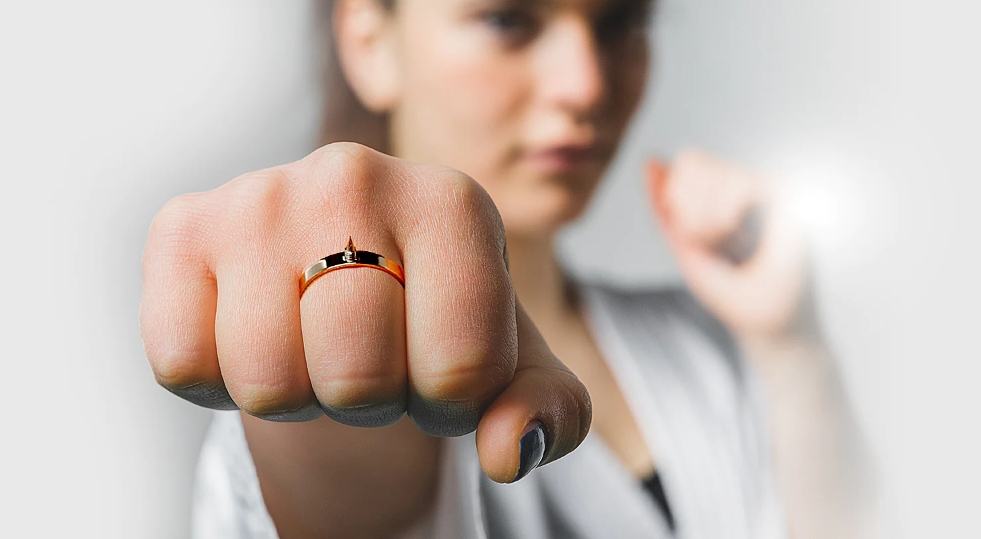Personal security is one of the most crucial concerns in such a dynamic world. For women, the potential of empowering themselves with self-protection is both the desired and the required.
When working through this whirlwind of self-defense maneuvers, we prioritize giving the ladies concrete advice and means to feel safe and blissfully assured in their capability to defend themselves.
Keep reading to know how to defend yourselves.
Non-Lethal Self-Defense Tools
In self-defense, the focus on personal safety has stimulated the creation and popularity of non-deadly weapons as reasonable substitutions for traditional arms.
The use of non-lethal self-defense tools enables people, especially women, to have realistic alternatives that could make potential perpetrators change their minds before committing atrocities instead of killing them.
This section focuses on new, affordable, non-lethal tools and analyzes their efficacy, operability, and associated legal implications.
Pepper Spray
Pepper spray is a powerful, non-lethal self-defense weapon made of hot peppers and infused with capsaicin.
Operating by making a temporary person incapable because of an intense irritation of eyes, skin, and respiratory apparatus, pepper spray is indispensable in harmful approaches to the person’s doubt.
Its capability in close quarters, usually 6 to 12 feet, makes the projectile functional in various conflicts, whether people or beasts there are included. Users face legal challenges where laws determine the ability to purchase and deploy them while differing from one jurisdiction to another.
Accurate use relies on treatment, specific strategies, knowledge of the wind’s direction, and the person’s responsibilities.
Pepper spray not only proves to be an effective means of protecting an individual but also becomes a gadget used only in a responsible way and safe for those who follow a logical path to defend themselves in a world that changes by the day.
Personal Alarms
From the ready-to-conceal keychains to those that integrate discreetly into wearable accessories or are tacked on to protect personal space, you can pick your alarm based on your choice.
Selecting the proper personal alarm guarantees one can get through the community with an audible alert of self-safety.
1. Keychain Alarms
Being lightweight, portable, and inconspicuous, keychain alarms are intended to blend into day-to-day activities.
Many are small, like the multi-functional safety keychain set with custom strap, but much more powerful to be carried easily and readily available when required.

Upon actuation, they will generate a high-volume alert sound to discourage attempted burglars and as a call for assistance to nearby individuals.
The above sentence is famous for people who move around with keychain alarms.
2. Wearable Technology Alarms
Given modern smart devices, wearable technology has become a fact of life in personal security.
Personal alarm devices for the human body are usually available in discreet forms such as bracelets, pendants, or clips.
With built-in innovative features, these alarms can be connected to any mobile-enabled device capable of sending automated alerts to pre-programmed contacts in case of activation.
The fact that the wearable alarms function so discreetly aids in attracting the fashion-conscious and security-conscious consumer.
3. Motion Sensor Alarms
Sensor alarms work on motion, and along with deploying the latest technology, the functions automatically trigger when there is a movement within the defined perimeters.
The alarms are critical, especially for securing the individual given space, for instance, the hotel rooms or the home.
Whenever activated, they produce a loud noise; hence, it is a deterrent to someone who has intruded on properties and is an alarm to individuals of possible danger.
Motion sensor alarms are more based, complementing personal carry to divert security.
4. Personal Safety Horns
Personal safety horns give a loud signal as an aid in a problematic emergency.
They mimic the sound of the old trumpets and are manually operated to produce a shout that can be heard over an extended range of places.
Such horns are applicable in open spaces and are mainly dominant in outdoor activities, and since the message is heard far away, one cannot get away from it.
Advantages Of Using Alarms To Attract Attention And Deter Attackers
The use of alarms and the increased visibility in the form of deterrents and attention grabbers has benefits and help improve personal safety on different occasions.
1. Immediate Deterrence
The alarm set’s high volume and attractive nature scare would-be attackers in the first seconds, which amounts to deterrence in the actual sense.
The sudden noise disrupts their end states, creating a feeling of ludicrousness that can dissuade the fighters from further aggressive action.
2. Draws Public Attention
Alarms are made at large distances, so a person can hear them from many miles away, catching people’s attention nearby.
For the intended effect, this attracts the attention of the bystanders, security persons, or law enforcers to the situation, which makes them more likely to provide help and intervention.
3. Creates a Distraction
Alarms produce a high sound force, which can be highly uncomfortable or even painful, and a distractor, shifting the attacker’s attention.
This distraction gives the potential victim a rare but usable chance to run since the attacker could be in a ‘fog’ or driven by the alarmed whistle.
4. Increases Visibility of the Situation
Alarms not only alert people in an auditory manner but also indicate, with visual prominence, the situation at hand.
What causes flashing or other indicators usually include signaling an invisible presence of threat, in a way perceived through sight, along with hearing the sound of the alarm, further increasing the chances for fast assistance.
5. Simple and Portable
One of the most vital aspects of personal alarms is their portability and lightweight nature, which makes them an efficient tool used by people of any age and physical limitations.
The portability makes them convenient and stimulates their not-to-be-left-home practice, thus ensuring constant access to protection.
Stun Guns and Tasers
Combining stun guns or Tasers technique into a personal protection plan requires not only know-how of the weapon mechanisms but also following the law and being responsible in the use of the latter.
As in any self-defense tool, knowledge, training, and rules observance work out one of the best options to benefit from it and eliminate the risks as much as possible.
A stun gun is a device applied in the hand as a weapon to stun a threat through an electrical shorting.
They generally have two direct metal prongs which are aimed at the target.
As it is triggered, the stun gun administers an electric shock of a high voltage but a low amperage current into the muscles, which results in the temporary dysfunction of the nervous system and muscle function.
This makes the victim disoriented and quickly rendered immobile, thus allowing them to run away.
On the other side, tasers are electro-shock weapons that operate remotely. They traverse and land with the help of compressed nitrogen that propels two tiny probes connected with conductive wires on the target.
As soon as the probes touch their intended objects, a charge of electric current is delivered, and this causes the person affected to experience neuromuscular incapacitation.
Tasers can sometimes be effective at as much as 15 feet away, giving them a certain level of standoff capability.
Though both stun guns and Tasers have shock electricity to rescue themselves, the main difference is the ways of delivery. While stun guns work on direct contact, the Tasers can overcome distances with probes and wires.
Legal Considerations
Stun guns and Tasers can be legal in some jurisdictions but are illegal in others, where restrictions on possession and use are imposed.
It is important to note that people must abide by the local laws governing the use of such devices. Some areas may need a permit or restrict their use to particular situations.
Safety Tips:
- Read and Understand the User Manual: Before using a stun gun or Taser, ensure that you have read and understood the user manual provided by the manufacturer.
- Aim for Target Areas: In case of a stun gun or Taser, aim at the assailant’s large muscle groups, like the torso or thigh. Do not aim at sensitive areas such as the face or neck.
- Practice Proper Distance: Understanding the effective range for Tasers is essential. Deploying probes from a safe distance ensures their proper operation and reduces the risk of close-quarters confrontation.
- Follow-Up Actions: When you use a stun gun or Taser, take the chance to flee for safety. These devices render a short-term advantage and must use the incapacitation time intelligently.
- Regular Maintenance: Maintain the device in good condition by periodically checking the batteries, probes, and overall functionality.
- Training and Familiarity: Get proper training on using these devices from trusted sources. Training enhances confidence, ensures responsible use, and reduces the risk of erroneous discharge.
Self-Defense Weapons
During the quest for personal security, the arsenal of available personal defense armament has grown outside the domain of conventional weapons.
One can find small, compact, inconspicuous tools and high-tech weapons.
Every weapon satisfies an individual, regardless of gender, with an opportunity to defend oneself in various circumstances.

Concealed Carry Firearms
It is a difficult choice for some to realize that the most effective protection they can carry would be concealed; therefore, it is a personal, complex decision.
Those exploring this opportunity must consider considerations around personal safety issues for them and their family, seeming or real threats in their world, as well as a general sense of self-reliance.
Knowledge about the issues one faces while hand-carrying a hidden firearm is implied for such owners from both moral and legal perspectives.
Training
Responsible ownership of firearms always includes proper training.
Those who choose concealed carry should be required to undergo suitable training programs that include comprehensive knowledge of firearm safety, marksmanship, situational awareness, and understanding of what kind of shots they can fire in case of confrontation.
Proper proficiency is established and retained, and individuals have historically been provided with tools that allow them to make decisions without undue haste or undue regard for risk when in highly pressurized situations.
Licensing
In most territories, a concealed carry permit is required as a prerequisite for anyone attempting to carry a firearm.
Licensing generally requires submitting official documents to pass certain background checks, get fingerprinted, and attend training courses.
Local legislation, therefore, should be obeyed since, in some states, possessing concealed guns without a given permit may have a judiciary consequence.
Legal Aspects
The legal aspects of concealed carry do so much because of the same. The individuals should be well acquainted with the rules about using force beyond reasonable restrictions in their jurisdictions.
It is, therefore, essential to understand the justification for drawing or discharging a firearm legally, as misuse of drawing arms or discharge for action is subjected to aggravation on criminal and civil liabilities.
Moreover, knowledge concerning the presence of no-gam zones and other restrictions is also crucial for the sensible gun owner.
Tactical Pens
A tactical pen, which appears so inconspicuous, cleverly conceals such an impressive weapon as an effective self-defense tool.
Crafted with durability in mind, these pens are designed to serve a dual purpose: as a trusted pen and a secret source of self-defense.
The reinforced pen construction is attributed to its use efficiency in self-defense cases.
- Striking Tool: The pen’s nib can be employed as a bully point for administering strikes on an assailant’s weak points, which provides an opportunity to defend oneself against the attack.
- Pressure Points: Pressure points, dangerous sensitive areas of the body, can be treated with a pen, which makes it more effective in incapacitating an assailant.
- Stabbing Motion: When it becomes necessary to defend oneself immediately, the pen can be used in a stabbing motion, leaving a knife-like wound that would render the assailant incapable of pursuing further action.
- Joint Manipulation: The pen is a sturdy body that can apply pressure to joints, ensuring the attacker is momentarily immobilized.
Benefits of Carrying Something Inconspicuous but Effective
The fact that tactical pens are unobtrusive devices but very efficient emphasizes the practical purpose of self-defense and their seamless integration into everyday lifestyle.
Their subtle look and multifaceted functionality give people an extra sense of safety when dealing with the world externally while leaving comfort and lawfulness intact.
- Blends into Daily Items: One significant factor that makes a tactical pen stand out is its understated style, which makes it possible to seamlessly integrate into the everyday environment and avoid attracting unnecessary attention and suspicion.
- Legal and Social Acceptance: In most parts of the world, it is not only socially acceptable to have a pen on you but also a fact that it is perfectly legal to carry a pen around.
- Versatile Utility: Apart from the ability to repel attackers, a tactical pen is still helpful for writing. This dual operation makes it a valuable item in everyday use that adds functionality to its covert nature.
- Accessible and Portable: Tactical pens are also small and light; therefore, they are easy to keep in a pocket or a handbag. This convenience assures that people have a security tool at hand anywhere and whenever it is required.
- Non-Lethal Option: Contrary to more common weapons, a tactical pen is a non-lethal instrument that aims to provide a means of escape or alienation, not harm.
Physical Self-Defense Techniques
martial arts and self-defense classes offer excellent survival techniques, each finding a distinct way to ensure safety.
Physical fitness works as a ground for the inclusion of the strength, endurance, and mental toughness one needs to use defense skills in a life situation.
Martial Arts
Martial arts include various techniques, each with different methods of self-protection. One example is the practical and valuable martial art of Krav Maga, developed by the Israeli military.
In Krav Maga, movements are automatic, and defense is done along with the attack process. Practitioners learn skills to neutralize threats rapidly, making it widely used for practical self-defense.
Brazilian Jiu-Jitsu (BJJ)
Being ground-fighting-based, Brazilian Jiu–Jitsu focuses more on leverage and technique than pure physical strength.
Practitioners learn how to dominate and submit opponents through wrestling and chokes, making it an efficient defense strategy, especially in knock-down duels.
Self-Defense Classes
Outside traditional martial arts, focused self-defense courses aim at real-life scenarios.
These classes often blend techniques from different fields, offering practical approaches to escape holds, defend against armed attackers, and deal with common threats.
Self-defense courses pay particular attention to situational awareness, verbal de-escalation, and physical approaches that individuals can apply regardless of their physical condition.
Importance of Physical Fitness in Self-Defense
By practicing some form of martial art or joining an equipping self-defense training program, pursuing a culture of physical fitness and skill development can help an individual proactively defend themself in today’s changing world.
1. Enhanced Strength and Agility
Physical fitness is an essential element of a successful defense.
Many types of exercise, such as strength training and cardiovascular activities, improve general strength and mobility.
Improvements in physical fitness allow humans to react quickly and efficiently to threats, enhancing their capability to perform self-defense moves.
2. Endurance and Stamina
When it comes to self-defense, endurance and stamina are critical. One advantage of physical fitness is better cardiovascular efficiency, which helps people maintain energy levels during stressful situations.
This stamina is necessary to avoid danger or enter into a long fight.
3. Improved Reflexes and Coordination
Routine physical activity improves reflexes and coordination, essential to performing accurate self-defense techniques.
Good reflexes allow quick response, and fine coordination helps us use martial arts or defensive movements efficiently.
4. Confidence and Mental Resilience
Physical fitness does not only benefit the body but also promotes mental strength and self-confidence.
Understanding what one is capable of physically creates confidence, allowing people to handle and navigate seemingly threatening circumstances with a clear mind.
Digital and Technological Solutions
This part of the paper evaluates the convergence of technology and self-defense across mobile applications, wearable devices, etc.
Using the digital topography’s functionalities, these techniques provide people with new ways to improve their safety and security.
Safety Apps
Personal security has created safety apps, which are irreplaceable tools for personal safety since they provide people with better opportunities to maneuver in their surroundings.
These applications commonly feature location-sharing abilities, trouble alerts, and live communication settings to provide safety measures. I
By tapping into mobile technology, these applications enable the users to remain connected with connections they can trust, request immediate assistance, and send their real-time location data.
Such technological implementation makes the extent of the immediate solution much higher and comforts their clients with a notion that help is only a tap or away.
Wearable Devices
As such, safety apps have become essential in personal security and have helped individuals move around their environments with enhanced security.
These applications usually come with features like location sharing, emergency SOS alerts, and live messages, providing a diverse way for personal protection.
These apps use smartphones to communicate with trusted contacts, quickly seek assistance, and provide a current location.
The introduction of technology not only allows for quick response in cases of emergency but also provides a feeling of security, knowing that assistance is just a tap away.
Pros:
- Discreetness and inconspicuous design.
- Quick and easy accessibility.
- Seamless integration into daily routines.
- Variety of stylish options available.
- Continuous innovation in design.
Cons:
- Technology and electronic dependability.
- Possible high price for advanced wearables.
- Based on legal limitations in some territories.
Choosing the Right Self-Defense Option
Through prudent assessment of these considerations, individuals can act upon what is an effective self-defense tool to defend themselves in the fight to build personal safety and integrity.
- Technological Reliability: Assess the dependability and lifespan of the tech that will be used for the tech-based solutions to prevent unintended failure during crucial times.
- Maintenance Requirements: Figure out how the identified tool needs to be maintained to work effectively and ensure dependability.
- Effect on Personal Safety Confidence: Consider how the chosen tool boosts the sense of safety confidence and the comfort that arises from that confidence in virtually all circumstances.
- Effectiveness: Background standard tools have proven helpful in the real world when supported by testimonials, reviews, or any other evidence of their success from a recognized expert.
- Cost: Pay attention to the cost of upkeep and purchasing the selected option of self-defense to ensure cost-effectiveness and value for money at the same time.
Conclusion: Empowering women to feel safer in their ability to protect themselves
Finding safety and control for oneself is a goal we all actively seek, especially for women infused in a world where security issues remain commonplace.
As such, self-defense tools and methodology selection should be taken more carefully.
But by assessing criteria of compliance with the law, convenience of carrying, training, use, and versatility, women can make decisions based on their lifestyle peculiarities and needs.



